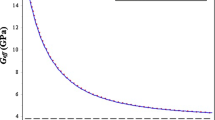Conclusions
1. Demineralized human compact bone is a physically nonlinear material with a nonuniform distribution of deformation parameters over the bone cross section.
2. At the initial moment of stressing (σ11=0), the modulus of elasticity of demineralized tissue is 380 times less than that of normal tissue. The minimum value of this parameter is in zone 6 (3.32 kgf/mm2) and the maximum value is in zone 1 (7.12 kgf/mm2). With increasing stress, the tangential modulus of elasticity increases.
3. The specific energy of deformation under the same stressing conditions σ11/σ*11 expended is greater for demineralized bone than for normal bone.
4. The parameter of cross-sectional deformation\(\bar \mu \) 12 upon stressing (at σ11/σ*11 from 0.1 to 0.3) increases for demineralized tissue by a factor of 1.56, while for normal tissue this increase is only by a factor of 1.01. The average values of\(\bar \mu \) 12 0·1 and\(\bar \mu \) 12 0·3 for demineralized tissue are 3.3 and 2.2 times, respectively, higher than for normal tissue.
5. The greatest correlations for the deformation parameters were found between the internal and external layers of the cross-sectional zones for E 01 (0.94) and\(\bar \mu \) 12 0·3 (0.87), though the discrepancies in the zones between the internal and external layers are insignificant (p>0.05).
6. The changes in the deformation parameters over the cross section have a positive correlation (with the exception of U 0.31 ) with the amount of ground substance in normal tissue (determined relative to hexosamine).
7. The deformation parameters of demineralized tissue may be described by a multi-dimensional linear equation using quantitative indices of the major biochemical components (hydroxyproline, phosphorus, and hexosamine) of normal tissue, which characterize the amounts of collagen, mineral substance, and ground substance, respectively.
Similar content being viewed by others
Literature cited
R. A. Robinson, "An electron microscopic study of the crystalline inorganic component of bone and its relationship to the organic matrix," J. Bone Jt. Surg.,34A, 389–434 (1952).
G. Reich, Collagen [Russian translation], Moscow (1969).
L. I. Slutskii, The Biochemistry of Normal and Pathologically Altered Connective Tissue [in Russian], Leningrad (1969).
E. N. Biryukov and I. G. Krasnykh, "Change in the optical density of bone tissue and the metabolism of calcium in cosmonauts A. G. Nikolaev and V. I. Sevast'yanov," Kosm. Biol. Med., No. 6, 42–46 (1970).
V. T. Zhigure, L. B. Neiman, I. V. Knet-s, and Kh. A. Yanson, "The dynamics of change of some deformation and strength parameters of bone regenerated at various stages of its formation," Mekh. Polim., No. 5, 937–941 (1976).
L. J. Harris, "Vitamin D and bone," in: The Biochemistry and Physiology of Bone, New York (1956), pp. 581–622.
A. A. Rauber, Elastizität und Festigkeit der Knochen, Leipzig (1876).
K. K. Gil'zen, "The specific weight, elasticity, and strength of bone tissue," Izv. St. Petersburgsk. Biol. Lab.,2, 7–37 (1896).
R. D. Harkness, "Biological functions of collagen," Biol. Rev.,36, 399–463 (1961).
R. W. Mack, "Bone — a natural two-phase material," Tech. Mem. Biomech. Lab. Univ. Calif. San Francisco (1964).
A. W. Sweeney, R. K. Byers, and R. P. Kroon, Mechanical characteristics of bone and its constituents," ASME Paper, No. 65-WA/HUF-7 (1965).
A. Ascenzi and E. Bonucci, "The tensile properties of single osteons," Anat. Rec.,158, 375–386 (1967).
J. Brunck, "Eine neue histologische Schnelldiagnostik knochenhaltigen Gewebes am Operationstisch," Zentralbl. Pathol.,86, 338–340 (1950).
R. E. Morris and R. S. Benton, "Studies on demineralization of bone. 2. The effect of electrolytic technics in demineralization," J. Clin. Pathol.,26, 596–603 (1956).
P. V. Skal'din, E. D. Savchenko, and M. F. Popov, "The electrolytic decalcification of bone," Arkh. Patol., No. 4, 122–124 (1956).
S. I. Vasilov and Ya. E. Khesin, "The use of electrodialysis for the simultaneous fixation and decalcification of bone tissue," Arkh. Patol., No. 3, 80–81 (1958).
V. S. Peschanskii and G. S. Libinson, "A bath for the electrolytic decalcification of bone," Arkh. Patol., No. 3, 85–86 (1964).
Yu. Zh. Saulgozis, I. V. Knet-s, and Kh. A. Yanson, "Coefficients of cross-sectional deformation of human compact bone tissue," Mekh. Polim., No. 6, 1089–1100 (1973).
I. V. Knet-s, Yu. Zh. Saulgozis, and Kh. A. Yanson, "The deformativity and strength of compact bone tissue upon stretching," Mekh. Polim., No. 3, 501–506 (1974).
Yu. Zh. Saulgozis, L. I. Slutskii, I. V. Knet-s, and Kh. A. Yanson, "A study of the relationships between various mechanical parameters and the biochemical composition of human bone tissue," Mekh. Polim., No. 1, 138–145 (1973).
I. Liepa, Biometrija [in Russian], Riga (1974).
Additional information
Institute of Polymer Mechanics, Academy of Sciences of the Latvian SSR, Riga. Translated from Mekhanika Polimerov, No. 1, pp. 101–108, January–February, 1978.
Rights and permissions
About this article
Cite this article
Dobelis, M.A. Deformation properties of demineralized human compact bone tissue upon stretching. Polymer Mechanics 14, 85–91 (1978). https://doi.org/10.1007/BF00859566
Received:
Issue Date:
DOI: https://doi.org/10.1007/BF00859566




